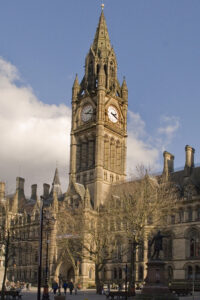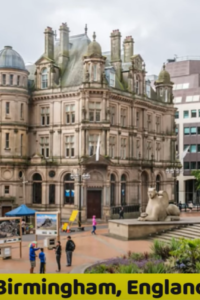Whether you’re interested in history and art, classic and modern architecture, or cuisine and scenery, London will surely satisfy every kind of interest.
It is the best city for foodies for its vast restaurant options and a haven for art and history buffs with its remarkable landmarks, museums, and art galleries.
The city has become a melting pot of cultures throughout the years.
Moreover, it is widely known as one of the best cosmopolitan cities in the world and it is not difficult to see why.
Apart from incredible places to see and tastes to explore, London has one of the largest and most efficient public transport networks and vast private transportation options.
Whether you prefer to travel by land, air, or river, London has got it all to help you discover the city like a local.
If you plan to move or just travel to London, read this complete guide on public transport in London.
The guide covers everything you need to know about public transport, including fares, maps, and comparisons. In this article, you will learn about the following topics:
- Ways to Travel Around London
- How to Pay for Public Transport in London
- Fares of Public Transport in London
- Which Public Transportation in London Is the Best?
- Maps for Public Transport in London
- Recommended Articles for More Information
- Did You Find This Guide Helpful?
Contents
- 1 Ways to Travel Around London
- 2 How to Pay for Public Transport in London
- 3 Fares of Public Transport in London
- 4 Which Public Transportation in London Is the Best?
- 5 Maps for Public Transport in London
- 6 Recommended Articles for More Information
- 7 Did You Find This Guide Helpful?
Ways to Travel Around London
Getting around London is either affordable, fast, or convenient, depending on the mode of transportation you use.
The city has a plethora of transportation options to suit all types of passengers. You don’t have to worry about finding transportation in the city since there are services available on every corner.
Whether you are traveling in the wee hours, during the day, or late at night, there is a public or private transport you can ride at any time.
Choose between train or rail services, buses or trams, or car or bike rentals. If you’re in the city center, walking is another great option to see the sights within walking distance.
By Train, Tube, or Rail
London Underground
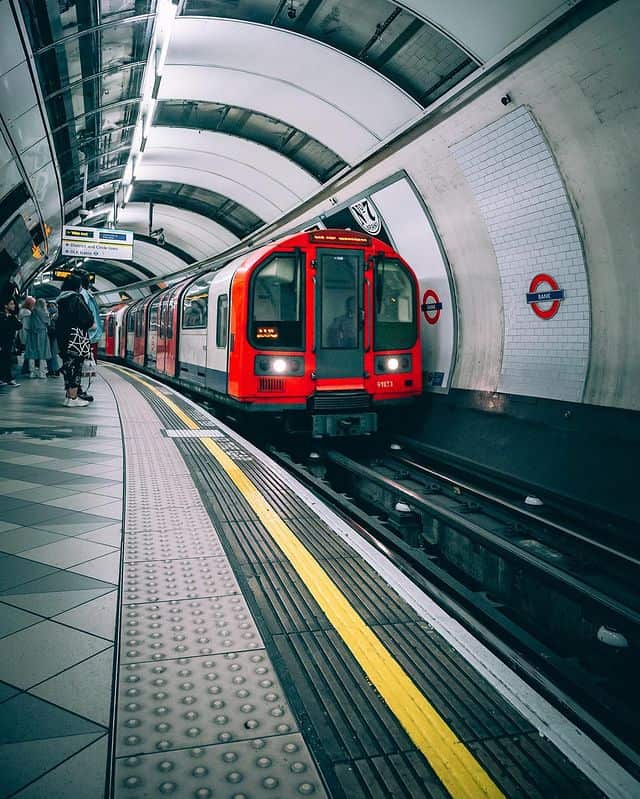
The London Underground is also referred to as the “Tube”. It covers 272 stations and 11 lines in a track length of 402 km.
The 11 lines of the London Underground are the Bakerloo line, Central line, Circle line, District line, Hammersmith & City line, Jubilee line, Metropolitan line, Northern line, Piccadilly line, Victoria line, and Waterloo & City line.
Each line has a designated color in order to easily find them on the map and see all the London Underground stations per line.
It is one of the most efficient and affordable modes of transportation to travel around the city, especially in Central London. Thus, it is no surprise about 1.35 billion passengers use the Tube every year.
If you need to travel at night, the London Underground has the Night Tube as well, which operates during late evenings and early mornings.
Night Tube is available on the Central line, Jubilee line, Northern line, Piccadilly line, and Victoria line on Friday and Saturday evenings. Use the Night Tube map to know which stations to ride to for the night.
London Overground
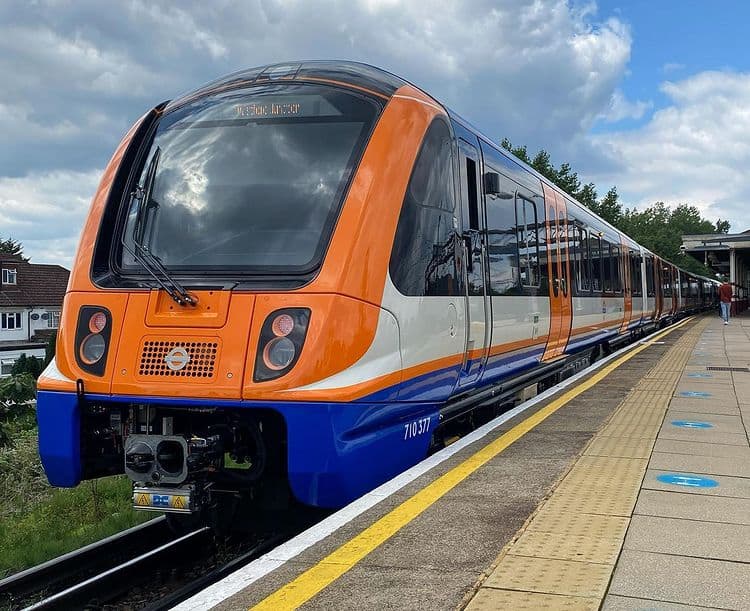
If you plan to venture out of Central London and into the outer areas of Greater London, the London Overground is the most ideal transportation.
It has six lines and 112 stations managed by Arriva Rail London and Network Rail under the Transport for London (TfL).
The six lines are Gospel Oak to Barking Riverside line, East London line, Watford DC line, Lea Valley line, Romford-Upminster line, and North London line.
Unlike the London Underground with multiple colored lines on the map, the London Overground uses only an orange double line despite having six lines.
You can easily transfer to and from the London Overground through interchanges available at several Tube lines, Docklands Light Railway (DLR), Elizabeth line, and National Rail.
Similar to Night Tube, you can travel late at night on the weekends with the London Overground Night Service.
There are usually four train services every hour but can be fewer depending on the route.
To learn more about the times, refer to the London Overground timetables or get live status updates from TfL.
Learn how to ride the London Overground by reading the guide here.
Docklands Light Railway (DLR)
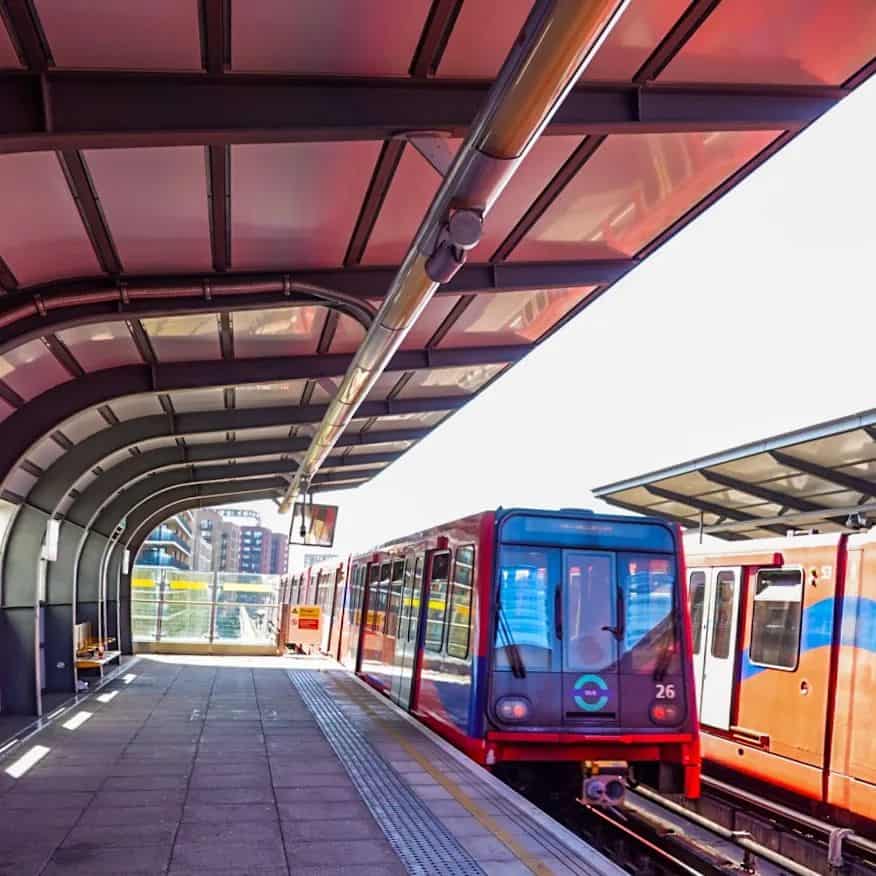
The DLR is a driverless mode of transportation running services from the east and southeast areas in the London Docklands region, the City of London, and Canary Wharf.
It is an automated light metro transport with 45 stations and five routes. Although it is considered driverless, there is still a train attendant on board as part of train management.
The train runs on five routes, from Bank to Lewisham, Bank to Woolwich Arsenal, Stratford to Lewisham, Stratford International to Woolwich Arsenal, and Tower Gateway to Beckton.
You can find the routes on the map by locating the turquoise-colored lines. Check the DLR Timetable to know about the updated arrival and departure times of each DLR route.
Transferring to other public transportation from the DLR is also easy thanks to the interchanges available.
There are interchanges for London Overground, Elizabeth line, London City Airport, National Rail, London Underground, and Emirates Cable Car.
Read the guide on Riding the DLR London to learn more about DLR tickets, maps, zones, and stations.
National Rail
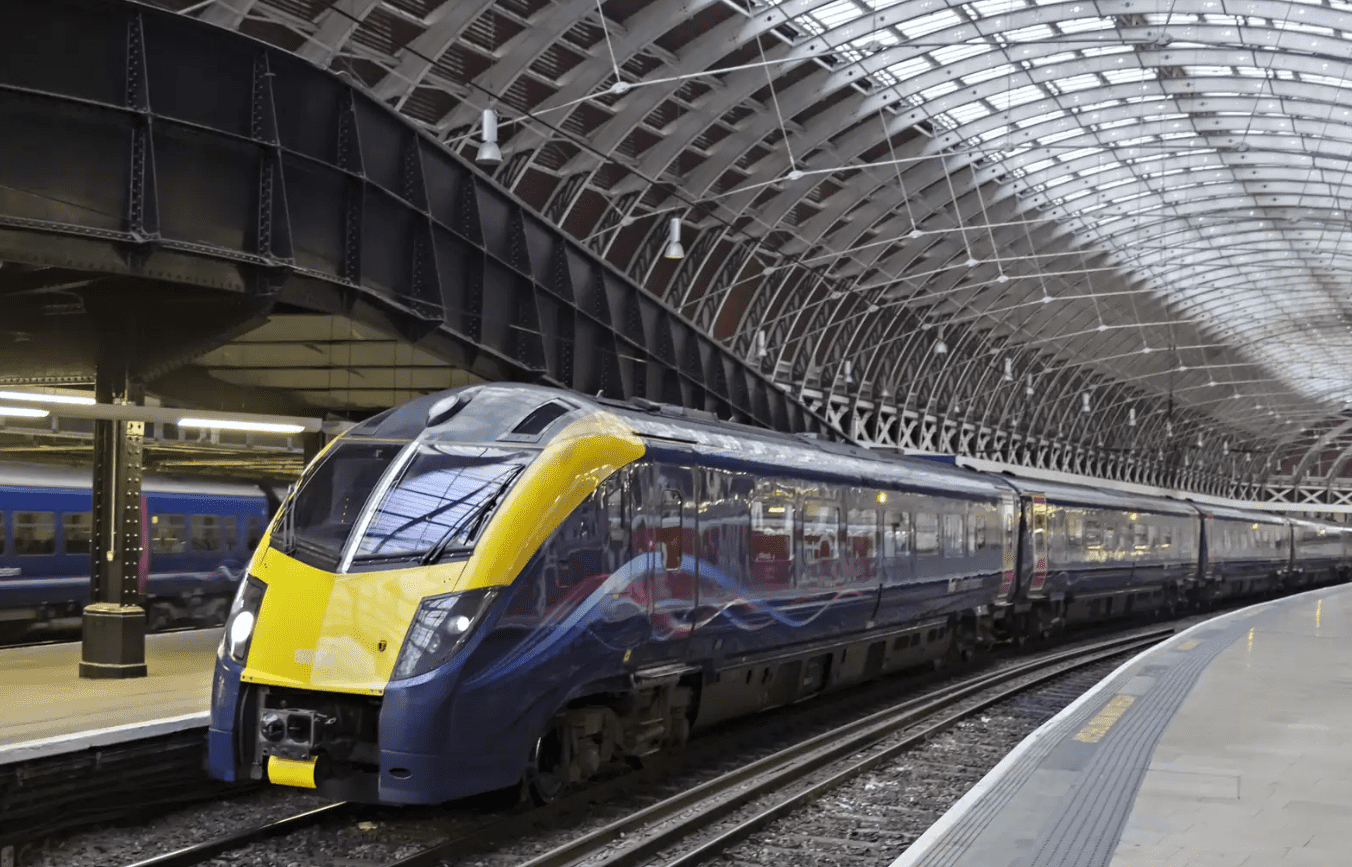
The National Rail (NR) was introduced in 1999 as a public transport provider owned by the Rail Delivery Group.
It provides passenger railway services beyond London and forms a part of some train lines of London Overground, London Underground, and Heathrow Express. To find the NR stations on the National Rail Map, look for a red double arrow symbol.
You can also use the National Rail Train Operators Map to see all interconnected lines, including Avanti West Coast, c2c, Chiltern Railways, CrossCountry, Southeastern, Elizabeth Line, Thameslink, Eurostar, South Western Railway, Greater Anglia, Great Western Railway, Hull Trains, Southern, and Great Northern.
NR serves more than 500 train stations and Sleeper Trains operating from Sunday to Friday nights.
By Bus and Trams
London Bus
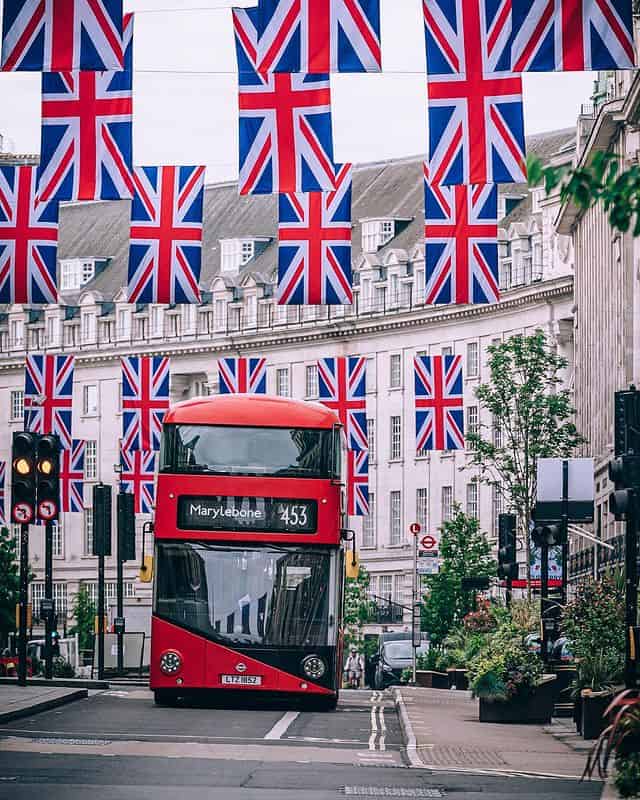
Riding the red London buses is the best way to see all the landmarks while commuting. It operates 24 hours a day on almost every street in London.
Buses carry approximately two billion passengers each year with 9,300 vehicles.
Today, there are 675 routes and approximately 19,000 bus stops. With so many routes and bus stops available, you need to download the map of the specific bus route you wish to take.
You can download a PDF map using Find Spider Maps or check all buses available in the city using the bus map of TfL.
Take note that London buses do not accept cash payment upon riding. You have to use a payment card purchasable at stations.
For more information, read the London Bus Guide to know how to get around London by bus.
Tram
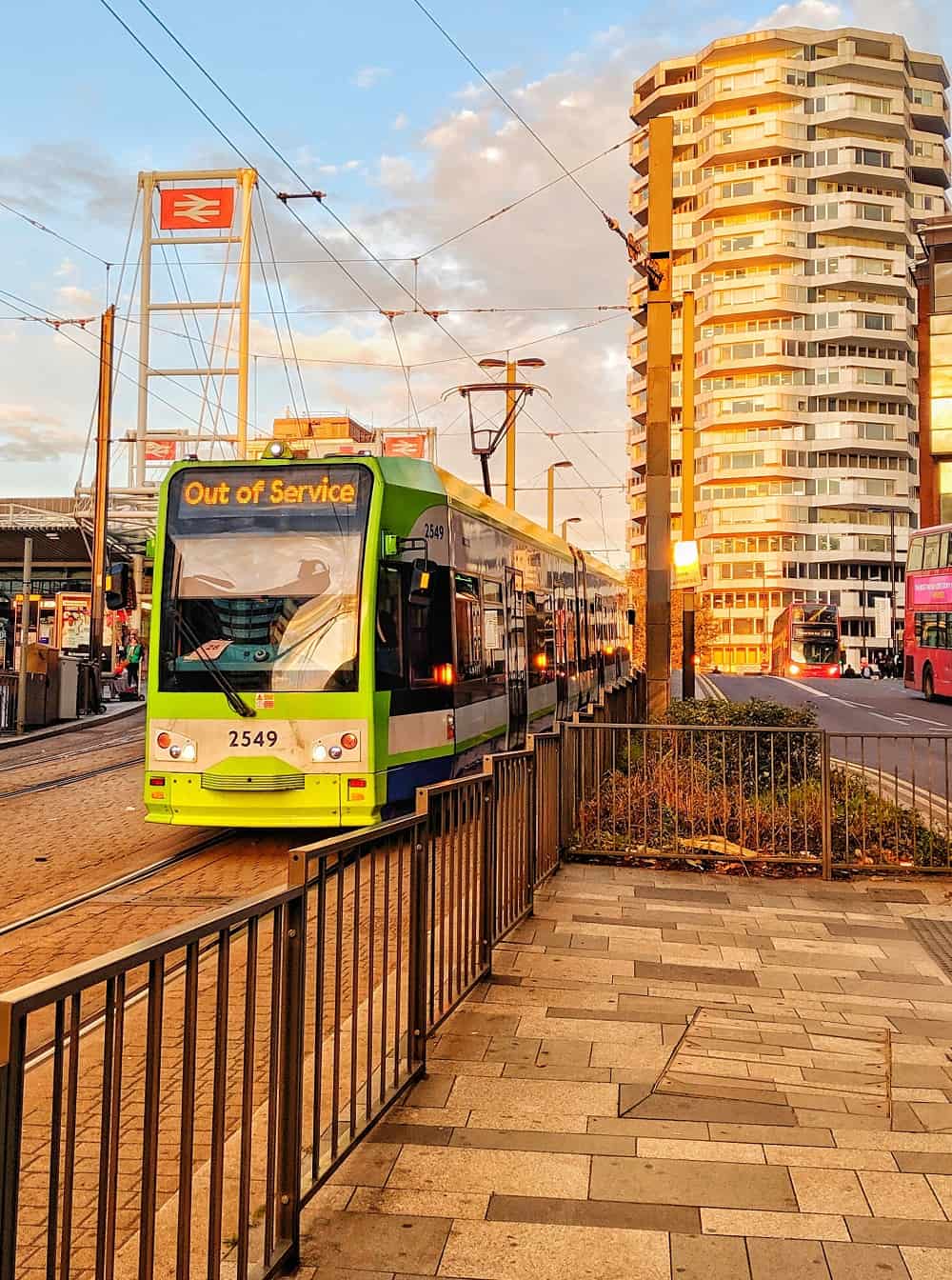
Hopping on the London tram is one of the most affordable ways to travel across the city.
It is commonly known as Tramlink or Croydon Tramlink and is currently owned by TfL with the operations handled by FirstGroup. There are more than 27 million tram trips made annually.
Today, it runs on three routes with 39 stops. Check the complete list of Tram Routes and Stations for the three tram routes: Beckenham Junction to Wimbledon, Elmers End to Wimbledon, and New Addington to Church Street.
Some of the tram stops have interchanges to other public transportation such as the National Rail, London Overground, and the District line of the London Underground.
To find the London tram routes on the Tube and Rail Map, look for the green-colored solid lines. Before starting your tram ride, check the Tram timetable to get the most updated schedules.
Read more about the London tram’s history, fares, and stations to help you with your commute.
By Air
Emirates Cable Car
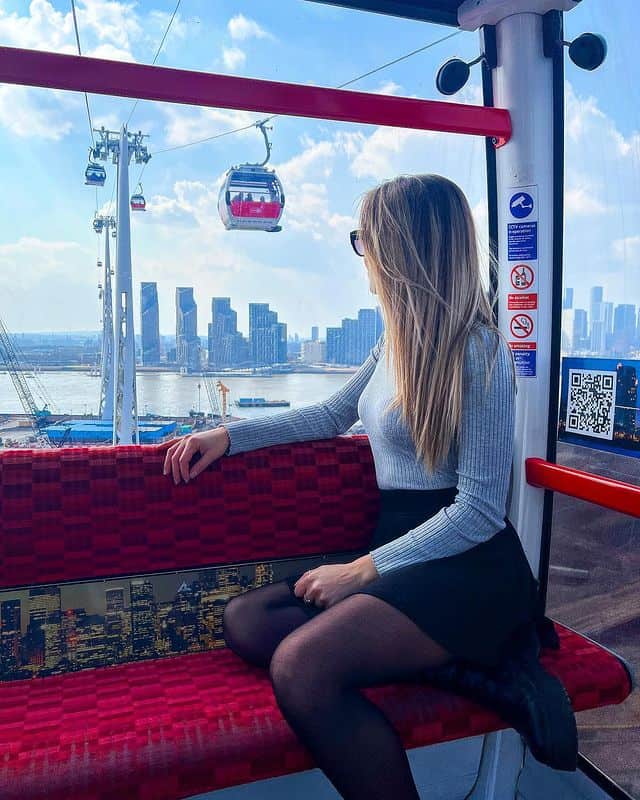
Cable cars in London are known as Emirates Cable Cars. However, the name will change to IFS Cloud Cable Car in October 2022. The 0.62-mile gondola line carries 10 passengers in each gondola.
Passengers are lifted up in the air up to 90 meters above the River Thames.
More than 1.3 million passengers ride the cable car every year from the two terminals: Emirates Greenwich Peninsula and Emirates Royal Docks.
From the cable car terminals, you can easily transfer to the nearest stations available.
For instance, the nearest transportation options from Emirates Greenwich Peninsula are the North Greenwich station of the Jubilee line, North Greenwich bus station, Cutty Sark on DLR, and North Greenwich Pier for the ferry.
As for Emirates Royal Docks, you can transfer to Canning Town on the Jubilee line, Bridgeland Road bus stop, Royal Victoria of DLR, and Royal Wharf for the ferry.
Learn how to book an Emirates Cable Car for an adventurous tour.
By River
River Bus
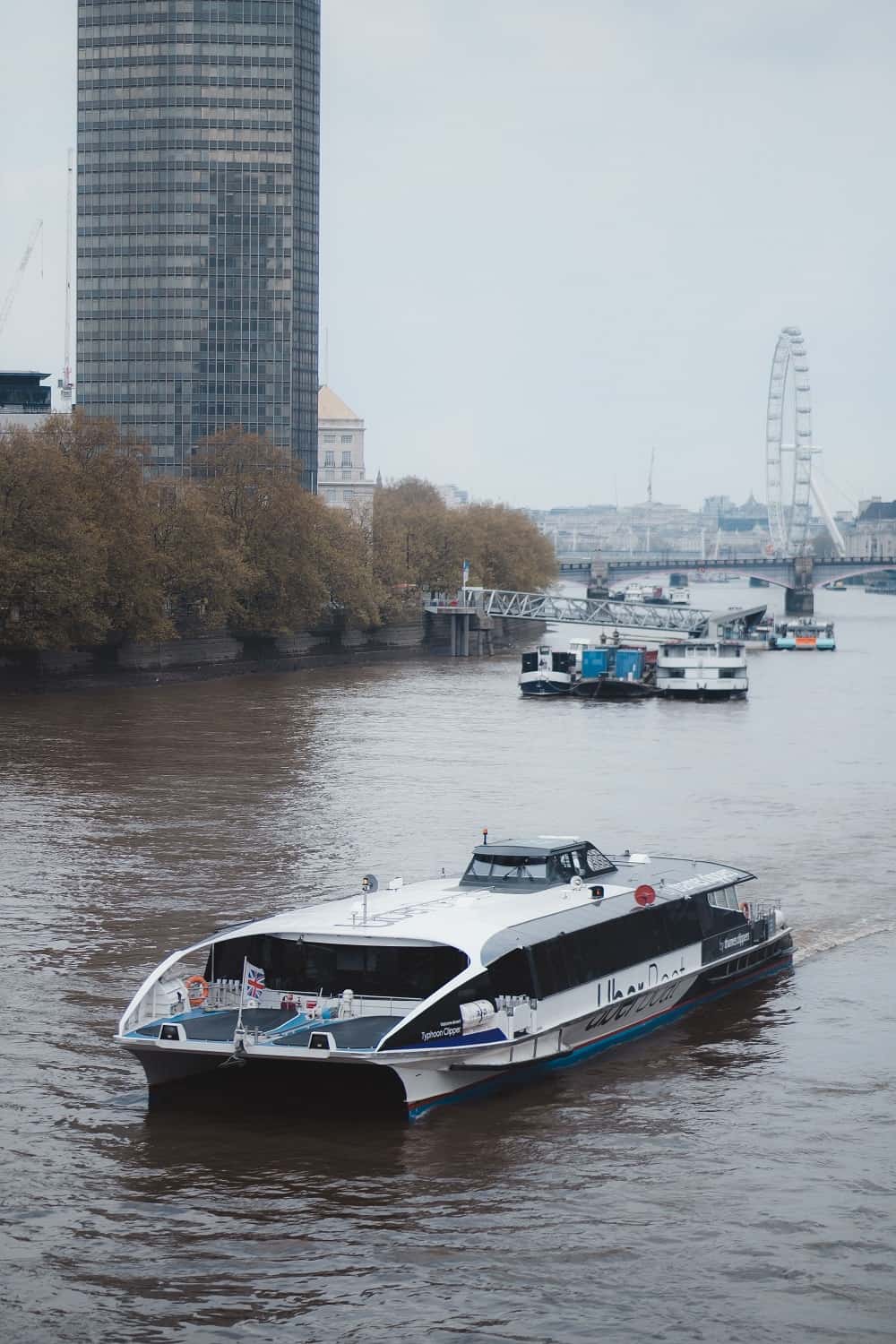
The River Bus offers a fast commute away from traffic while having the best scenic views of the city.
Get off from pier to pier with boats by Uber Boat by Thames Clippers. It is one of the most comfortable public transportation that offers passengers a sure seat.
However, if you get seasick a lot, you might want to take medication for motion sickness to help.
There are 34 London river piers and the River Bus will take you to its 24 piers. Transferring to another public transportation is easy with the available nearby interchanges such as London Underground, Southwestern Railway, London Overground, National Rail, DLR, and Elizabeth line.
Choose between four routes for your journey: RB1, RB2, RB4, and RB6. The earliest services of RB1 are from the Battersea Power Station Pier at 07:55 am and from the Barking Riverside Pier at 06:25 am.
If you plan to ride the cable car as well, you can get a combined ticket for both public transport for a great price.
By Rentals and Private Hires
Driving
Going on a road trip with your own vehicle offers the convenience and flexibility you need for a smooth sailing journey.
If you plan to drive in London, it is best to read the detailed visitor‘s guide on driving in London to learn about the charges you may have to pay, documents needed, road rules to know, and routes to avoid.
First and foremost, you need a valid and full driving licence in order to drive in London.
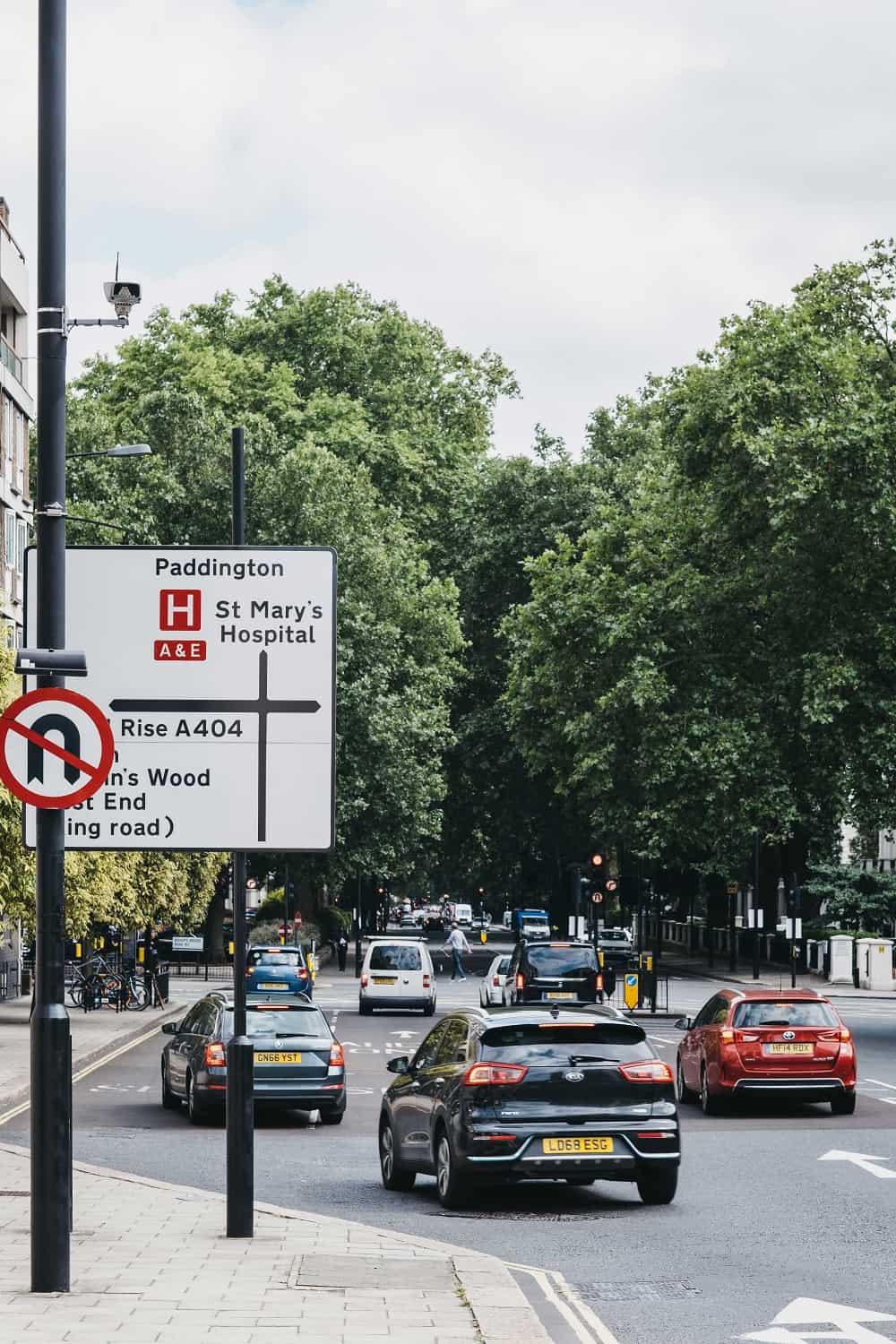
If your license is non-GB (Great Britain), check first if it can be used to drive in London. The next thing you need to check is if your vehicle is emissions and safety standards compliant.
In this way, you can avoid charges such as Ultra Low Emission Zone (ULEZ) and Low Emission Zone (LEZ) charges.
However, the only charge that may be unavoidable is the Congestion Zone Charge, especially when you have no choice but to pass through the Congestion Zones.
Check out my guide How to Avoid The Congestion Charge to save some money.
Don’t forget to read The Highway Code manual from the Department for Transport and know the Red Routes for short-term and prohibited parking spots.
Not to worry, there are numerous station car parks available across various locations in the UK that are mostly open 24 hours.
Cycling
If you like breezy air and a bit of exercise, renting a bike is the most ideal way to get around London.
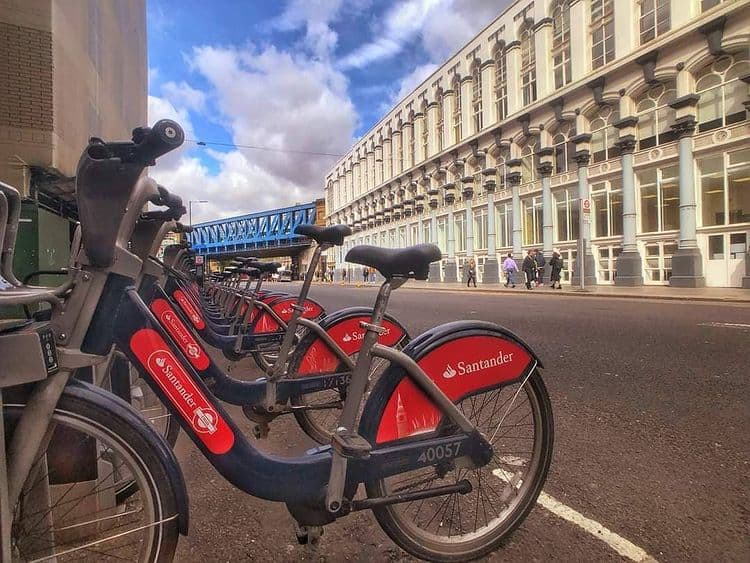
Santander Cycles are London bike rentals that cost £1.65 for 30 minutes.
However, there are other bike rental options in London offering various packages and coverage such as LimeBike, HumanForest, Dott, Freebike, Swapfiets, and TIER.
Over 12,000 cycles are available for rent at approximately 800 docking stations today.
Download the Santander Cycles app to rent a bike. Alternatively, you can go straight to the nearest docking station from your location and have a bank card ready for payment at the terminals.
When using Santander Cycles, the app or the terminal will give you a “release code” in order to unlock a bike for use. The code should be entered on the keypad of the bike slot within 10 minutes.
To learn more about how to rent a bike, don’t forget to read the detailed instructions here.
Taxi
London is not only famous for its iconic red buses but for black taxi cabs as well. When you see hackney carriages with a “for hire” or “taxi” sign lit up, these are the taxis you can hail on the street.
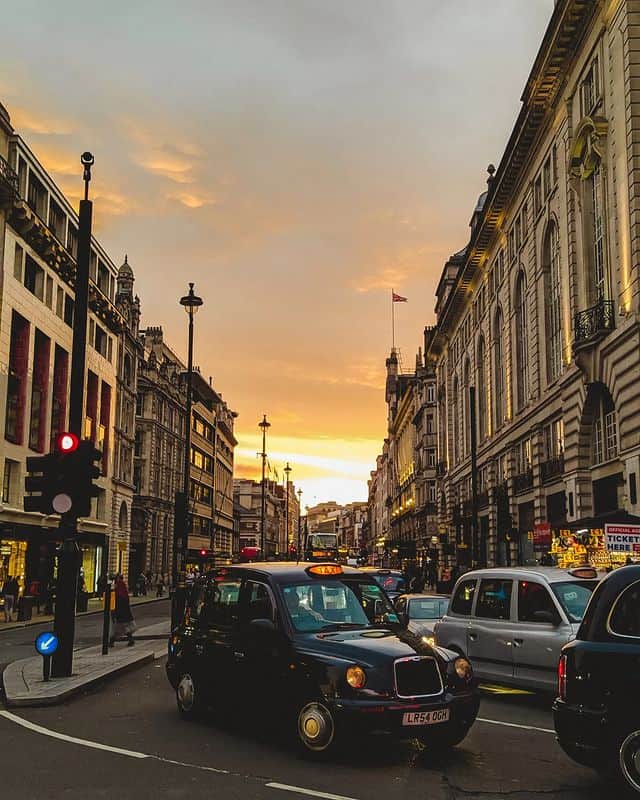
Although black-colored taxis are more dominant, you will also find other colors as well such as gray, red, and even pink.
If you aren’t sure if it is a licensed taxi for hire, check if the driver is wearing either a green or yellow badge with the driver’s badge number.
Moreover, licensed taxis should also have either a green or yellow license on the front and read the windshields of the vehicle.
Lastly, it should have a white vehicle license plate with complete information such as license number, vehicle registration number, maximum passenger capacity, and expiration date.
A taxi typically has a minimum charge of £3.80 and a Tariff is applied with varying fares, depending on the total miles traveled.
Aside from black taxis, there are several private cars for hire such as minicabs and chauffeurs from popular taxi apps like Uber, FREE NOW, and Gett.
To know how to ride Black Taxis and private hires, read the guide for first-timers here.
On Foot
Walking
For short or long distances, walking will surely be a delightful experience with London’s incredible walking routes in the West End and the City of London.
On top of that, you can always take a relaxing break with London’s abundance of green spaces for a walk with nature. There are seven interesting walking routes if you would like to explore Central London.
You can walk through the Capital Ring, Green Chain, Jubilee Greenway, Jubilee Walkway, Lea Valley, London Outer Orbital Path (LOOP), and Thames Path routes.
If you want to take a break from taking the Tube and rail, you can always walk from station to station. Sometimes, walking can be a quicker option in Central London than taking the Tube.
Know how long it takes to reach a station with TfL’s walking times for Zones 1-3, Zones 1-2, and journeys within Central London. If you need guidance during your walk trip, download the Go Jauntly app which has all the walking routes for an easier journey.
You can also find Tube stations and Cycle Hire stations and learn about accessibility details, walking times and steps, and more.
How to Pay for Public Transport in London
Choose the Correct Payment Card
Times have changed and paying for commodities is simple and easy with smartcards and payment devices.
Although buying paper tickets in cash is still possible in most stations, the most affordable and convenient way to pay for your fare is using Pay as you go cards such as Oyster Cards, Contactless Cards, and Visitor Oyster Cards.
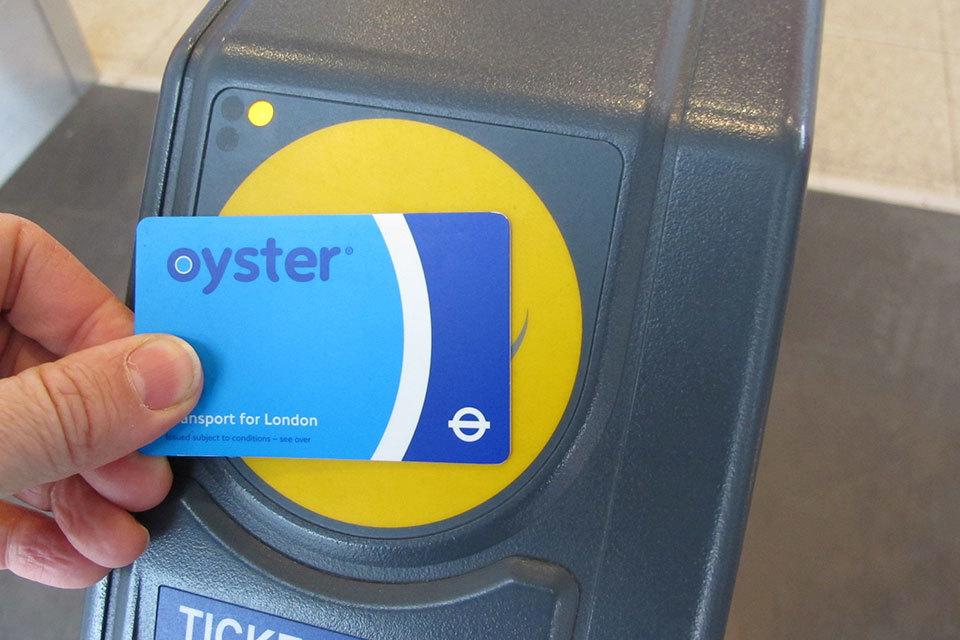
If you’d like to travel as much as you want without a limit, you can use TfL’s Travelcards or Bus & Tram Passes.
For journeys on the River Bus and Emirates Air Line, you can also buy a ticket online if you don’t have any of the payment cards mentioned.
To help you decide which payment type is best for your travel, refer to the guide Visitor Oyster Card Vs Oyster Card Vs Travel Card Vs Contactless Card.
The table below shows a quick summary of which payment type can be used for each public transport in London.
Summary Table of Payment Cards for Each Public Transport
| Payment Type | Public Transport |
| Oyster Card |
|
| Visitor Oyster Card |
|
| Contactless Bank Card or Device |
|
| Bank card, Santander Cycles app, or Membership key | Santander Cycles (Pay as you ride with a bank card) |
| Travelcard (Unlimited Journeys) |
|
| Bus & Tram Pass | Buses and Trams in London |
| Online Tickets |
|
Select the Zones and Times
Keep in mind that London uses Fare Zones to calculate your total fare.
Each transportation station is categorized according to nine zones: Zone 1 to Zone 9. Knowing which zones your itinerary will cover will help you decide on the type of payment card and its area validity and price.
Generally, the more zones your payment card covers, the higher the fare.
Apart from Fare Zones, you also have to consider the times of your travel. Take note that journeys made during peak times are usually more expensive than those made during off-peak times.
Check the Peak Time and Off-Peak Time Table below of the Tube, DLR, London Overground, Elizabeth line, and National Rail services in London.
Peak Time and Off-Peak Time Table
| Pay as you go | Day Travelcard | ||
| Peak Time | Monday to Friday (except on public holidays)
06:30 am to 09:30 am 16:00 pm to 19:00 pm |
All travels starting, stopping, or passing through Zone 1 that are either going to or coming from Heathrow Airport using Tube and Elizabeth line.
Journeys from Watford Junction to Euston (Southbound) Monday to Friday (except on public holidays) 06:30 am to 09:30 am Journeys from Euston to Watford Junction (Northbound) Monday to Friday (except on public holidays) 16:00 pm to 19:00 pm |
Anytime Day Travelcard
Starting from the date of use of the ticket until 04:29 am the next morning |
|
Off-peak TIme |
Monday to Friday
09:31 am to 15:59 pm 19:01 pm to 06:29 am |
Journeys coming from other Zones entering Zone 1
Monday to Friday 16:00 pm to 19:00 pm Journeys from Watford Junction to Euston (Southbound) Monday to Friday 09:30 am to 06:29 am Journeys from Euston to Watford Junction (Northbound) Monday to Friday 19:01 pm to 15:59 pm (next day) Night Service Journeys |
Off-peak Day Travelcard
Monday to Friday 09:30 am onwards (for the whole day)
Saturday, Sunday, Public Holidays Starting from the date of use of the ticket until 04:29 am the next morning Night Service Journeys Starting from the date of use of the ticket until 04:29 am the next morning
|
Learn How to Touch In and Touch Out
Another important thing to remember is to know the correct way of touching in and out for each public transportation.
As you enter the station, you will come across a gated area with a yellow card reader. The yellow card reader is where you will have to touch in or tap your payment card to enter.
When you have reached your destination, you can exit the station by touching out or tapping the yellow card reader again before passing through the barriers. Knowing your start and end stations will help determine the correct fare.
Touch In and Touch Out Summary Table
| Method | Public Transport |
| Touch in (entrance) and touch out (exit) |
|
| Touch in only |
|
| Touch in (yellow card reader), touch a pink card reader, and touch out (yellow card reader) | Touch the pink card reader when changing trains within London except Zone 1 |
If you do not follow the correct way of touching in and out, you might have to pay a penalty fare of £80.
However, if paid within 21 days, the penalty can be reduced to £40. Aside from the penalty fare, you may be charged the maximum fare since the correct fare cannot be determined.
Maximum Fare Table
| Area | Peak Hours | Off-peak Hours |
| Zone 1 to Zone 9 stations (except Heathrow Express) | Maximum £8.90 | Maximum £6 |
| Beyond Zone 9 | £26.00 | – |
| Broxbourne, Rye House, St Margarets, Ware and Hertford East | £9.10 | £6.80 |
| Chafford Hundred, Grays, Ockenden and Purfleet | £9.10 | £8.10 |
| Dartford and Swanley | £8.90 | £6 |
| Epsom | £9.80 | £7.20 |
| Shenfield | £10.50 | £7.80 |
| Watford Junction | £10.30 | £7 |
| Merstham | £13.20 | £9 |
| Cuffley | £10.60 | £8 |
| Bayford and Hertford North | £11.50 | £9 |
| Redhill, Earlswood | £14.50 | £9.50 |
| Salfords, Horley | £14.70 | £9.50 |
| Gatwick Airport | £19 | £11.50 |
| Heathrow Express (Paddington to Heathrow) | £25 | £25 |
| St Pancras International | £14.40 | £10.60 |
| London Victoria | £20.60 | £20.60 |
| Brookmans Park and Welham Green | £10.70 | £7.80 |
| Welwyn Garden City | £12.50 | £9.70 |
| Luton Airport Parkway | £16.90 | £13.10 |
| Reading | £26 | £11.30 |
Do Not Exceed the Maximum Journey Times
Although there is a standard fare set for Pay as you go caps, you should only travel within the allowable journey duration.
If you exceed more than the maximum journey time on the Tube, DLR, London Overground, Elizabeth line, and National Rail services, you will be charged two maximum fares.
The maximum journey times vary on zones traveled, weekdays or weekends, and time of travel.
Check the table below for the complete times of the maximum journey per zone to help you stay within the allowable duration.
The table is for travels on the Tube, DLR, London Overground, Elizabeth line, and National Rail services.
Table of Maximum Journey Times Per Zone
| Zone | Monday to Friday
(04:30 am to 07:00 pm) |
Monday to Friday, (07:00 pm onwards)
Saturday |
Sunday |
|
1 hr 30 min. | 1 hr 40 min. | 1 hr 50 min. |
| Zones 1 to 2 | 1 hr 40 min. | 1 hr 50 min. | 2 hrs |
| Zones 1 to 3 | 1 hr 50 min. | 2 hrs 5 min. | 2 hrs 15 min. |
| Zones 1 to 4 | 1 hr 50 min. | 2 hrs 5 min. | 2 hrs 15 min. |
| 1 zone | 1 hr 10 min. | 1 hr 20 min. | 1 hr 25 min. |
| 2 zones | 1 hr 20 min. | 1 hr 30 min. | 1 hr 40 min. |
| 3 zones | 1 hr 30 min. | 1 hr 40 min. | 1 hr 50 min. |
| 4 zones | 1 hr 40 min. | 1 hr 50 min. | 2 hrs |
| 5 zones | 1 hr 50 min. | 2 hrs 5 min. | 2 hrs 15 min. |
| 6 zones | 2 hrs | 2 hrs 15 min. | 2 hrs 25 min. |
| 7 zones | 2 hrs 10 min. | 2 hrs 25 min. | 2 hrs 40 min. |
| 8 zones | 2 hrs 20 min. | 2 hrs 35 min. | 2 hrs 50 min. |
| 9 zones | 2 hrs 30 min. | 2 hrs 45 min. | 3 hrs |
| 10 zones | 2 hrs 40 min. | 3 hrs | 3 hrs 15 min. |
| 11 zones | 2 hrs 50 min. | 3 hrs 10 min. | 3 hrs 25 min. |
| 12 zones | 3 hrs | 3 hrs 20 min. | 3 hrs 40 min. |
| 13 zones | 3 hrs 10 min. | 3 hrs 30 min. | 3 hrs 50 min. |
| 14 zones | 3 hrs 20 min. | 3 hrs 40 min. | 4 hrs |
| 15 zones | 3 hrs 30 min. | 3 hrs 55 min. | 4 hrs 15 min. |
| 16 zones | 3 hrs 40 min. | 4 hrs 5 min. | 4 hrs 25 min. |
| 17 zones | 3 hrs 50 min. | 4 hrs 15 min. | 4 hrs 40 min. |
| 18 zones | 4 hrs | 4 hrs 25 min. | 4 hrs 50 min. |
| 19 zones | 4 hrs 10 min. | 4 hrs 35 min. | 5 hrs |
| 20 zones | 4 hrs 20 min. | 4 hrs 50 min. | 5 hrs 15 min. |
Fares of Public Transport in London
If you are traveling from Zones 1 to 9 using capped Pay as you go cards and Travelcards, there is no price difference between the Tube, DLR, Elizabeth line, London Overground, and most National Rail services.
The price only differs on the number of zones the card covers, peak or off-peak times, type of payment card, and passenger type.
For journeys made on buses and trams, you pay a standard Hopper Fare of £1.65 for unlimited rides within one hour.
Rates for children are either discounted or free as long as they have the appropriate Oyster photocard. Disabled persons, students, and apprentices also get free or discounted rates on public transportation.
To know more about the full list of fares, check the TfL’s Fares page or use Winterville’s detailed guides for each public transport.
Use the Single fare finder tool to know how much you have to pay from your start and end stations.
Alternatively, you can also use the Caps and Travelcard prices tool to know the fare from zone to zone.
The table below shows the adult rates for Pay as you go Caps and Travelcard, as well as other types of payment cards for each public transport in London.
Fares of London Public Transport Summary Table
| Public Transport | Fare | ||||||||
| Tube
Most National Rail services |
Zone |
Pay as you go caps (Adult fare) | Travelcard (Adult fare) | ||||||
| Daily Peak | Daily Off-peak | Monday to Sunday | Day Anytime | Day Off-peak | 7 Day | Monthly | Annual | ||
| Zone 1 only | £7.70 | £7.70 | £38.40 | £14.40 | £14.40 | £38.40 | £147.50 | £1,536 | |
| Zones 1-2 | £7.70 | £7.70 | £38.40 | £14.40 | £14.40 | £38.40 | £147.50 | £1,536 | |
| Zones 1-3 | £9.00 | £9.00 | £45.20 | £14.40 | £14.40 | £45.20 | £173.60 | £1,808 | |
| Zones 1-4 | £11.00 | £11.00 | £55.20 | £14.40 | £14.40 | £55.20 | £212.00 | £2,208 | |
| Zones 1-5 | £13.10 | £13.10 | £65.70 | £20.30 | £14.40 | £65.70 | £252.30 | £2,628 | |
| Zones 1-6 | £14.10 | £14.10 | £70.30 | £20.30 | £14.40 | £70.30 | £270.00 | £2,812 | |
| Zones 1-7 | £15.30 | £14.10 | £76.50 | £25.70 | £15.30 | £76.50 | £293.80 | £3,060 | |
| Zones 1-8 | £18.10 | £14.10 | £90.30 | £25.70 | £15.30 | £90.30 | £346.80 | £3,612 | |
| Zones 1-9 | £20.00 | £14.10 | £100.20 | £25.70 | £15.30 | £100.20 | £384.80 | £4,008 | |
| Zone 2 only | £7.70 | £7.70 | £28.80 | £14.40 | £14.40 | £28.80 | £110.60 | £1,152 | |
| Zones 2-3 | £9.00 | £9.00 | £28.80 | £14.40 | £14.40 | £28.80 | £110.60 | £1,152 | |
| Zones 2-4 | £11.00 | £11.00 | £31.90 | £14.40 | £14.40 | £31.90 | £122.50 | £1,276 | |
| Zones 2-5 | £13.10 | £13.10 | £38.20 | £20.30 | £14.40 | £38.20 | £146.70 | £1,528 | |
| Zones 2-6 | £14.10 | £14.10 | £48.10 | £20.30 | £14.40 | £48.10 | £184.80 | £1,924 | |
| Zones 2-7 | £15.30 | £14.10 | £49.90 | £25.70 | £15.30 | £49.90 | £191.70 | £1,996 | |
| Zones 2-8 | £18.10 | £14.10 | £67.90 | £25.70 | £15.30 | £67.90 | £260.80 | £2,716 | |
| Zones 2-9 | £20.00 | £14.10 | £67.90 | £25.70 | £15.30 | £67.90 | £260.80 | £2,716 | |
| Zone 3 only | £9.00 | £9.00 | £28.80 | £14.40 | £14.40 | £28.80 | £110.60 | £1,152 | |
| Zones 3-4 | £11.00 | £11.00 | £28.80 | £14.40 | £14.40 | £28.80 | £110.60 | £1,152 | |
| Zones 3-5 | £13.10 | £13.10 | £31.90 | £20.30 | £14.40 | £31.90 | £122.50 | £1,276 | |
| Zones 3-6 | £14.10 | £14.10 | £38.20 | £20.30 | £14.40 | £38.20 | £146.70 | £1,528 | |
| Zones 3-7 | £15.30 | £14.10 | £49.90 | £25.70 | £15.30 | £49.90 | £191.70 | £1,996 | |
| Zones 3-8 | £18.10 | £14.10 | £67.90 | £25.70 | £15.30 | £67.90 | £260.80 | £2,716 | |
| Zones 3-9 | £20.00 | £14.10 | £67.90 | £25.70 | £15.30 | £67.90 | £260.80 | £2,716 | |
| Zone 4 only | £11.00 | £11.00 | £28.80 | £14.40 | £14.40 | £28.80 | £110.60 | £1,152 | |
| Zones 4-5 | £13.10 | £13.10 | £28.80 | £20.30 | £14.40 | £28.80 | £110.60 | £1,152 | |
| Zones 4-6 | £14.10 | £14.10 | £31.90 | £20.30 | £14.40 | £31.90 | £122.50 | £1,276 | |
| Zones 4-7 | £15.30 | £14.10 | £36.10 | £25.70 | £15.30 | £36.10 | £138.70 | £1,444 | |
| Zones 4-8 | £18.10 | £14.10 | £60.80 | £25.70 | £15.30 | £60.80 | £233.50 | £2,432 | |
| Zones 4-9 | £20.00 | £14.10 | £60.80 | £25.70 | £15.30 | £60.80 | £233.50 | £2,432 | |
| Zone 5 only | £13.10 | £13.10 | £28.80 | £20.30 | £14.40 | £28.80 | £110.60 | £1,152 | |
| Zones 5-6 | £14.10 | £14.10 | £28.80 | £20.30 | £14.40 | £28.80 | £110.60 | £1,152 | |
| Zones 5-7 | £15.30 | £14.10 | £36.10 | £25.70 | £15.30 | £36.10 | £138.70 | £1,444 | |
| Zones 5-8 | £18.10 | £14.10 | £60.80 | £25.70 | £15.30 | £60.80 | £233.50 | £2,432 | |
| Zones 5-9 | £20.00 | £14.10 | £60.80 | £25.70 | £15.30 | £60.80 | £233.50 | £2,432 | |
| Zone 6 only | £14.10 | £14.10 | £28.80 | £20.30 | £14.40 | £28.80 | £110.60 | £1,152 | |
| Zones 6-7 | £15.30 | £14.10 | £36.10 | £25.70 | £15.30 | £36.10 | £138.70 | £1,444 | |
| Zones 6-8 | £18.10 | £14.10 | £60.80 | £25.70 | £15.30 | £60.80 | £233.50 | £2,432 | |
| Zones 6-9 | £20.00 | £14.10 | £60.80 | £25.70 | £15.30 | £60.80 | £233.50 | £2,432 | |
| Zone 7 only | £15.30 | £14.10 | £36.10 | £25.70 | £15.30 | £36.10 | £138.70 | £1,444 | |
| Zones 7-8 | £18.10 | £14.10 | £60.80 | £25.70 | £15.30 | £60.80 | £233.50 | £2,432 | |
| Zones 7-9 | £20.00 | £14.10 | £60.80 | £25.70 | £15.30 | £60.80 | £233.50 | £2,432 | |
| Zone 8 only | £18.10 | £14.10 | £60.80 | £25.70 | £15.30 | £60.80 | £233.50 | £2,432 | |
| Zones 8-9 | £20.00 | £14.10 | £60.80 | £25.70 | £15.30 | £60.80 | £233.50 | £2,432 | |
| National Rail fares |
To/From |
Pay as you go caps | Travelcards | *Pay as you go cap rates are for commutes made on National Rail, Elizabeth line, and London Overground beyond Zone 9. | |||||
| Daily peak | Daily off-peak | Monday to Sunday | 7 Day | Monthly | Annual | ||||
| Broxbourne, Hertford East, Ware, St. Margarets and Rye House | |||||||||
| Zones 1-8 | £27.00 | £20.50 | £104.90 | £104.90 | £402.90 | £4,196.00 | |||
| Zones 2-8 | £27.00 | £20.50 | £82.40 | £82.40 | £316.50 | £3,296.00 | |||
| Gatwick Airport (excluding Gatwick Express) | |||||||||
| Zones 1-9 | £35.20 | £22.40 | £119.50 | – | – | – | |||
| Horley, Salfords, Earlswood, Redhill and Merstham | |||||||||
| Zones 1-9 | £35.20 | £22.40 | £119.50 | – | – | – | |||
| Epsom | |||||||||
| Zones 1-6 | £20.00 | £14.10 | £100.20 | – | – | – | |||
| Cuffley | |||||||||
| Zones 1-6 | £20.00 | £14.10 | £100.20 | – | – | – | |||
| Bayford and Hertford North | |||||||||
| Zones 1-6 | £27.00 | £20.50 | £104.90 | – | – | – | |||
| Ockendon, Chafford Hundred, Purfleet and Grays | |||||||||
| Zones 1-6 | £27.00 | £20.10 | £100.80 | – | – | – | |||
| Radlett | |||||||||
| Zones 1-6 | £27.50 | £17.90 | £94.50 | – | – | – | |||
| Potters Bar | |||||||||
| Zones 1-6 | £26.40 | £16.60 | £88.10 | – | – | – | |||
| Watford Junction | |||||||||
| Zones 1-8 | £27.00 | £20.10 | £100.80 | £100.80 | £387.10 | £4,032.00 | |||
| Shenfield | |||||||||
| Zones 1-9 | £33.40 | £22.40 | £119.50 | £119.50 | £458.90 | £4,780.00 | |||
| Iver | |||||||||
| Zones 1-6 | £22.50 | £14.90 | £78.80 | – | – | – | |||
| Langley Berks | |||||||||
| Zones 1-6 | £25.20 | £15.90 | £84.30 | – | – | – | |||
| Slough | |||||||||
| Zones 1-6 | £26.00 | £16.50 | £97.60 | – | – | – | |||
| Burnham Bucks | |||||||||
| Zones 1-6 | £28.70 | £17.20 | £102.60 | – | – | – | |||
| Taplow | |||||||||
| Zones 1-6 | £31.40 | £18.40 | £107.60 | – | – | – | |||
| Maidenhead | |||||||||
| Zones 1-6 | £32.80 | £19.00 | £110.90 | – | – | – | |||
| Twyford | |||||||||
| Zones 1-6 | £38.60 | £22.70 | £126.00 | – | – | – | |||
| Reading | |||||||||
| Zones 1-6 | £59.40 | £27.70 | £153.10 | – | – | – | |||
| Bus and Tram | Hopper Fare | £1.65 London single bus fare (Unlimited travel within one hour of use) | |||||||
| River Bus | Zone | Pay as you go with Oyster or contactless, Online/App Purchase | Travelcard | ||||||
| One-Way | Round Trip | One-Way | Round Trip | ||||||
| West | £4.80 | £9.90 | £3.50 | £7.00 | |||||
| Central | £7.70 | £15.40 | £6.35 | £12.70 | |||||
| Central & West | £8.70 | £17.40 | £7.50 | £15.00 | |||||
| Central & East | £8.70 | £17.40 | £7.50 | £15.00 | |||||
| East | £4.80 | £9.90 | £3.50 | £7.00 | |||||
| All Zones | £13.50 | £ 27.00 | £9.80 | £19.60 | |||||
| Cross River – One-way | Barking Riverside Pier ↔ Woolwich (Royal Arsenal) Pier
£3.80 |
||||||||
| Doubletree Docklands Pier ↔ Canary Wharf Pie
£3.80 |
|||||||||
| Greenland (Surrey Quays) Pier ↔ Canary Wharf Pier
£3.80 |
|||||||||
| Emirates Cable Car | Emirates Greenwich Peninsula
↔ Emirates Royal Docks |
Pay as you go/ Online | Cash | ||||||
| One Way | Round Trip | One Way | Round Trip | ||||||
| £5 | £10 | £6 | £12 | ||||||
| Santander Cycles | Pay as you ride | Monthly membership (£20 per month) | Annual membership (£120 per year) | ||||||
| £1.65 per 30 minutes | Free one hour unlimited rides for one month + £1.65 for each additional hour | Free one hour unlimited rides for one year + £1.65 for each additional hour | |||||||
| Black Taxi | Distance | Taxi Time | Tariff 1 | Tariff 2 | Tariff 3 | ||||
| 1 mile | 6 to 13 minutes | £6.40 to £10 | £6.40 to £10.20 | £8 to £11.20 | |||||
| 2 miles | 10 to 20 minutes | £9 to £15.80 | £10.40 to £16 | £11.60 to £17 | |||||
| 4 miles | 16 to 30 minutes | £17 to £25 | £19 to £25 | £20 to £29 | |||||
| 6 miles | 28 to 40 minutes | £26 to £33 | £32 to £36 | £33 to £37 | |||||
| Between Heathrow and
Central London |
30 to 60 minutes | £52 to £97 | |||||||
| Up to 6 miles | – | £3.05 per mile | £3.74 per mile | £3.96 per mile | |||||
| Over 6 miles | – | £3.70 per mile | |||||||
If you’d like to compare the cost for each public transportation according to your destination, use TfL’s Plan a Journey tool.
After entering your start and end stations or locations, the tool shows all available transportation, travel time for each transport, and cost comparison.
For instance, if you are traveling from Oxford Street to London Bridge at 04:00 pm, the Journey Results shows cycling, walking, bus, and Tube options.
The cheapest mode of transportation for this route is the London Bus and Santander Cycle, which costs £1.65 at any time.
If you prefer to ride the Tube on this route, the price is higher at £2.50. Since the distance between the two locations is about 3.9 to 4.3 miles, a Black Taxi would cost around £17 to £25 for Tariff 1 or £19 to £25 for Tariff 2 on the weekends.
Sample Price Comparison Table
Oxford Street to London Bridge at 04:00 pm
| Transportation | Cost | Depart/Arrive | Travel Time |
| Bus | £1.65 anytime | 04:00 pm to 04:45 pm | 45 minutes |
| Tube | £2.50 anytime | 04:00 pm to 04:30 pm | 30 minutes |
| Cycle | £1.65 anytime | 04:00 pm to 04:29 pm | 29 minutes |
| Taxi | £17 to £25 for Tariff 1
£19 to £25 for Tariff 2 on the weekends |
04:00 pm to 04:33/04:35 pm | 33 to 35 minutes |
| Walk | Free | 04:00 pm to 05:09 pm | 1 hr and 9 minutes |
Which Public Transportation in London Is the Best?
There is no direct answer as to which transportation is the best since every passenger has their own preferences.
Some people prefer convenience over affordability, while some choose environmentally friendly transportation such as cycles rather than choosing to ride a faster mode of transportation like buses and trains. Whatever your priority is, there is public transportation that will surely suit you.
What do passengers look for in public transportation? Some of the first things passengers take into consideration are the price and convenience.
If you can have a hassle-free journey at affordable prices, that would definitely come first before anything else.
How about being efficient? You may want to go from one place to another while sightseeing in order to save time and have a fun commute.
All of these factors are explained in the table below for your reference.
Public Transport Comparison Table
| Best for… | Transportation |
| Affordability | London Bus and Trams are the cheapest public transportation in London. For a fixed Hopper Fare, you can travel as much as you want within one hour from the start of your journey. |
| Faster Travel Time | The London Underground is considered the fastest mode of transportation without being expensive compared to a Black taxi. Use Pay as you go cards or Travelcards to get the best fare cost. |
| Convenience | If you want to skip the lines and crowd while staying comfortable, riding the taxi is the best option. Taxis and private hires can be pre-booked from an app, so you don’t have to hail one on the street. |
| Sightseeing | Double-decker buses or Hop-on and Hop-off buses drive you around the city with the opportunity to see the top sights. |
| Accessibility | All public transportation in London is accessible for wheelchair users, persons with assistance dogs, and PWDs. |
| Scenic Views | For beautiful views of the city skyline, take the Emirates Cable Car or the Thames Chipper if you prefer scenic views. |
| Eco-friendly | The most eco-friendly mode of transportation is cycling or simply walking. It is inexpensive and offers a more customizable trip. |
| Airport Transfers | Tube, buses, and taxis are available going to and from the airport. However, taking a taxi is the most expensive option. Ride the Tube or bus for more affordable rates. |
| Travels Outside Central London | Driving or riding the London Overground and rail is the most ideal option for journeys beyond Central London. |
Maps for Public Transport in London
Maps are helpful when traveling by public transport in a new city. Preparing for a trip ahead of time and researching routes from maps can save you a lot of time and frustration.
If you need maps, you can download TfL’s maps below in PDF format.
Recommended Articles for More Information
Squeezing all information into one article can be overwhelming, so I recommend you refer to the following websites and articles listed below to further guide you on specific topics.
Get more tips and useful information on traveling in London. Moreover, you can create the ultimate itinerary with the help of the latest articles from Winterville.
Winterville
Find the best places to visit with Winterville’s plethora of London guides. If you’re looking for the best places to eat and drink, check out our detailed guides on the best afternoon tea spots in Kensington and Chelsea, the best brunch in Shoreditch, or the best bars and pubs in Richmond.
Winterville also has multiple guides on all things Japanese such as best Japanese restaurants in Mayfair and outstanding Japanese shops and supermarkets.
If you’re picking someone up at Heathrow Airport, use the guide Heathrow Airport Pick Up Guidelines, Fees, and Maps.
Looking for unique activities to do in London?
I recommend taking pottery classes or visiting Ichiba London – Japan Centre.
Lastly, don’t forget to stay safe and be alert of your surroundings at all times. It is best to read the guide on the safest and most dangerous areas in London.
Your safety is of utmost importance more than anything else.
Transport for London (TfL)
Transport for London is the main source of information for this guide. You can check the website for further reading on status updates, maps, fares, and many more.
Moreover, you can plan your journey accordingly with the help of TfL’s Travel tools.
Gov.UK
For more details on driving and transport in London, visit the Gov.UK, the official website for government services and information.
Learn more about driving licenses, penalty points, and the Highway Code, to name a few.
City of London
If you’d like to explore more about London’s green spaces, landmarks, and other things to do, visit the official website of the City of London.
Whether you are looking for places for shopping, eating and drinking, or admiring nature, the City of London has some guides for easy access.
Did You Find This Guide Helpful?
Riding public transport in an unfamiliar city can be daunting and adventurous at the same time.
That’s why it is always a good idea to come prepared and do further reading on basic guidelines on public transportation.
Thanks to the internet, you can easily find helpful information fast and conveniently.
Did this guide help you know the differences between each public transport in London?
Have you ever ridden public transport in London? Share your thoughts in the comments section. Don’t forget to share this article with other fellow travelers who need guidance.

